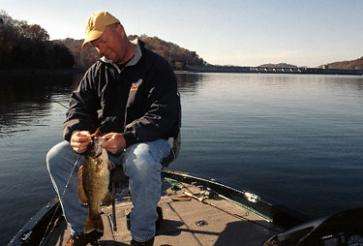
I can't tell you the first time I read all about thermoclines and how bass don't live beneath them, but I've read that same thing lots of times since then, and — based on my personal experience — it just ain't so.
I suppose that I should start by defining some terms, starting with "thermocline." The thermocline is a layer of water that develops in the summertime. That's when our lakes start to stratify and break up into three distinct layers from the top to the bottom.
In the top layer, the water's very warm and there's usually plenty of oxygen. In the bottom layer, the water's much colder, and there's very little oxygen. In the middle is the thermocline. It's where the temperature changes very quickly — from warmer to cooler as you get deeper — and there's still plenty of oxygen there.
All my life I've read about the thermocline being the best layer for summertime fishing, and — overall at least — it's probably true. All the books and magazines say it's where we should be fishing and that the water above it is too hot for much activity except very early and late in the day. Below the thermocline, they say there's almost no bass life since there's so little oxygen.
Well I'm here to tell you that you can catch summertime smallmouths below the thermocline … and that some of them will be big!
Largemouths may like warmer water, but smallmouths will avoid it if they can. One way to avoid it is to get below it — in the thermocline and even deeper. I know they're there because I've caught them.
I can't tell you that it happens everywhere or on every lake, but it definitely happens on my home waters of Dale Hollow Lake and on other deep, clear, infertile impoundments I've fished. If you fish waters like that, I bet it happens there, too.
So if they're holding below the thermocline, what are they doing there? Are they resting, feeding or what? Well, I'm not sure, but I'd guess that some of them are resting and will move up to grab a meal when they get hungry. Others are feeding below the thermocline. After all, bass forage such as shad and crawfish will sometimes hold below the thermocline, too. They don't need much oxygen to survive.
One of my favorite baits for below-the-thermocline-bassin' is a jig and chunk. That crawfish look is perfect for bass that are taking it easy and not looking to expend much energy to feed. Look for them on points and drops where you found them before summer stratification took place and after it goes away in the fall.
So don't believe everything you read, and don't believe you can't catch bass somewhere just because no one else has caught them there before





